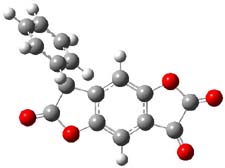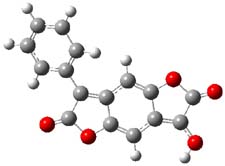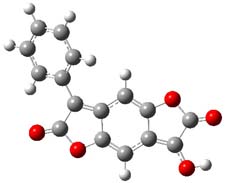The keto-enol tautomerization is an interesting system for probing relative energies of subtle effects, playing off different bond type (and their associated strengths) with conjugation and hydrogen bonding and strain. Lawrence and Hutchings have now extended this to include the interplay of aromaticity and antiaromaticity in the keto-enol tautomerization of benzodifurantrione 1.1 The keto form 1k looks to be the favotable tautomer, containing an aromatic phenyl ring. The enol tautomer 1e requires the loss of that aromatic ring. Nonetheless, the enol structure is the only tautomer present in the crystal phase, and the enol tautomer is the dominant structure (if not the exclusive structure) in all solvents tested, including acetic acid, acetone, acetonitrile, chloroform, DMF, DMSO, propanol and toluene. The only solvents where the keto form is dominant are toluene and o-dichlorobenzene.

So, how does one rationalize this equilibrium? The B3LYP/6-311G(2d,p) structure of the two tautomers are shown in Figure 1. Note that there are two isomers of the enol form, differing on the orientation of the hydroxyl hydrogen. The syn isomer is the lowest energy form, in both the gas phase and in solution (PCM modeling acetonitrile, chlorobenzene and THF). So the enol form is the lowest energy structure when there are no special interactions involving hydrogen bonding or dipolar interactions with the solvent – there is an inherent energy preference for 1e.
|
1k |
|
|
1e-anti |
1e-syn |
Figure 1. B3LYP/6-311G(2d,p) structures of the tautomers of 1.1
To address that, they computed the NICS(0) values for each ring in the two tautomers. The pendant phenyl group is aromatic in both structures, as expected. The lactone ring has NICS values near 0 in both structures. The interior phenyl ring is aromatic (NICS = -7.5) in 1k but is non-aromatic in 1e, with NICS=-0.4. So the aromaticity of this ring is lost upon enolization, and thus would favor 1k. However, the terminal ring in the keto tautomer has NICS = +7.2, suggesting that it is antiaromatic, and upon enolization, the ring becomes slightly aromatic, with NICS = -2.1. Thus, the keto form is plagued by an antiaromatic ring, which is then lost in the enol form. The result is the interplay between losing an aromatic ring and its stabilization when the enol is formed balanced by also losing an antiaromatic ring with its destabilization. The authors do not offer any quantization (rightfully so!) of the stabilization/destabilization associated with these rings. But very subtle effects are clearly at play.
References
(1) Lawrence, A. J.; Hutchings, M. G.; Kennedy, A. R.; McDouall, J. J. W., "Benzodifurantrione: A Stable Phenylogous Enol," J. Org. Chem., 2010, 75, 690–701, DOI: 10.1021/jo9022155
InChIs
1k: InChI=1/C16H8O5/c17-14-10-7-11-9(6-12(10)21-16(14)19)13(15(18)20-11)8-4-2-1-3-5-8/h1-7,13H
InChIKey=GNWKSKHSRUSFBC-UHFFFAOYAC
1e: InChI=1/C16H8O5/c17-14-10-7-11-9(6-12(10)21-16(14)19)13(15(18)20-11)8-4-2-1-3-5-8/h1-7,17H
InChIKey=MZLQKOSFMRKQIO-UHFFFAOYAB




Henry Rzepa responded on 13 Mar 2010 at 2:31 pm #
The designation of the rhs ring in 1k as anti-aromatic seems to be based purely on the NICS(0) value. It is difficult to see how any simple Hückel like rule based on 4n+2/4n counting could come up with that conclusion. Five membered rings are also rather fragile when it comes to NICS, since local ring currents from the σ-electrons tend to encroach. Certainly, a NICS(1) or a NICS(2) (1 and 2 Å above the plane respectively) would seem essential to verify the result. Another fuzzy effect is where to put the ring centroid for the NICS, since the ring in question has carbonyl groups and ring oxygens which might make the centroid based purely on the ring atoms less reliable (I have used the RCP, or ring critical point coordinates for this purpose, as determined by AIM. At least that is a coordinate determined by the electrons, and hence more directly associated with ring currents, even if only tenuously). There is also an assumption that NICS(0) inferred diatropicity is associated with significant π-resonance stabilisation. That too remains to be proven.
On this topic, years ago (Phenol-Keto Tautomerism in Tricyclic [10]Annulenes. H. S. Rzepa, J. Chem. Res (S) , 1982, 324-325 (S)) I investigated the same effect but based on 10 rather than 6 electrons. Curiously, little work has been done on the loss of aromaticity of larger annulenes (one presumes the effect attenuates as the rings get larger).